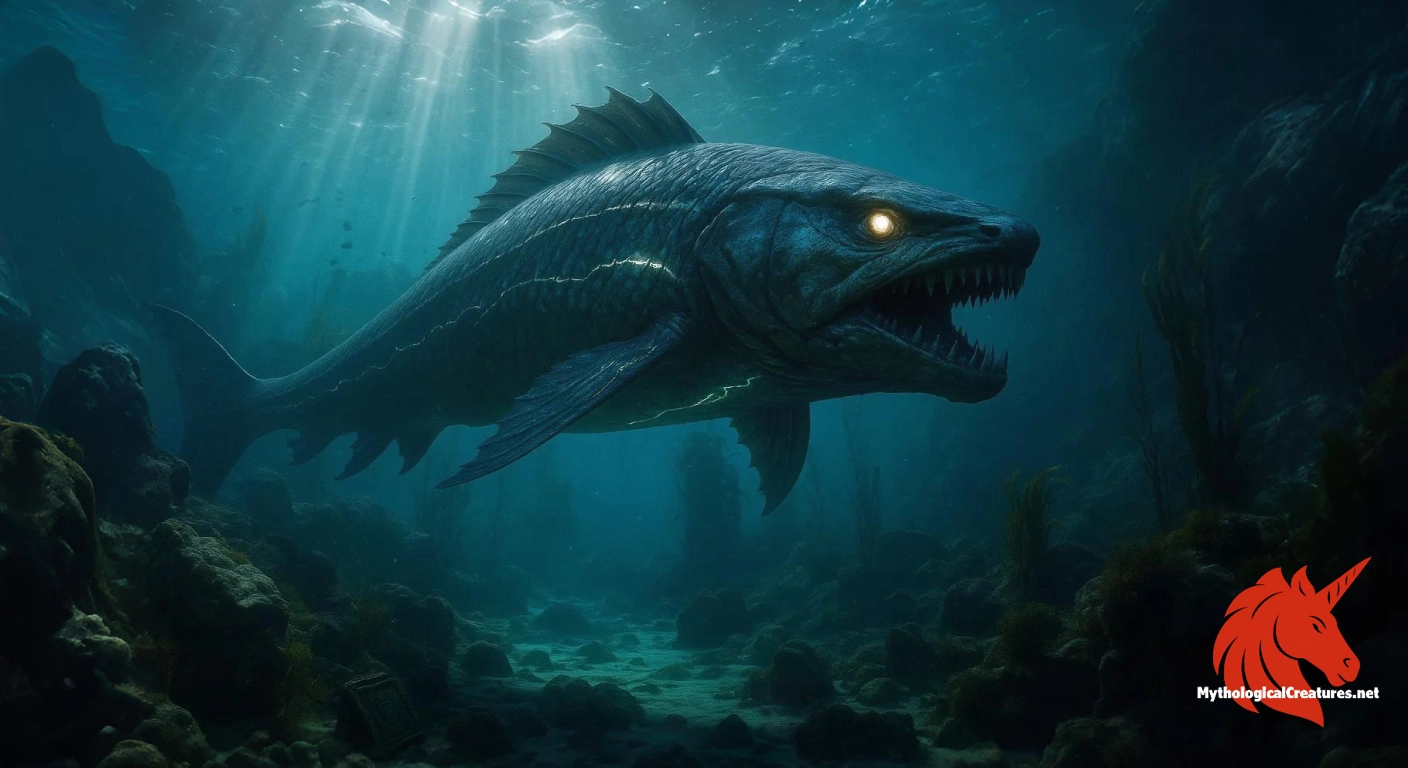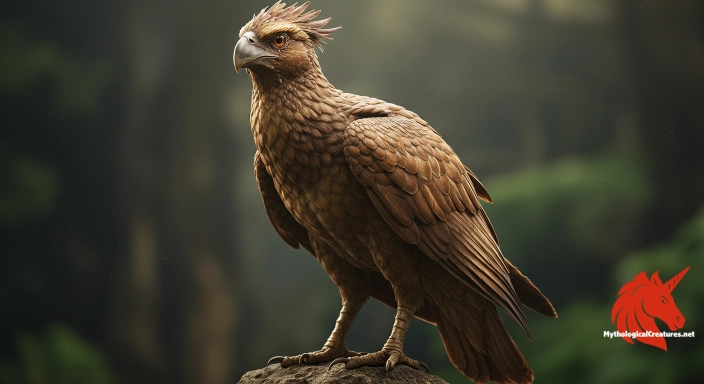Akugyo: Akugyo is an evil sea monster and aquatic yōkai from Japanese mythology.

Akugyo
Akugyo - Represents the malevolent and chaotic forces of the ocean in Japanese folklore, warning seafarers of the dangers beneath the waves.
Origins & First Encounters
Akugyo is a mysterious aquatic yōkai from Japanese mythology that has intrigued listeners and readers for centuries. It is known by multiple names, including daigyo (giant fish) and raichōgyo (thunderbird fish), each hinting at its imposing presence and supernatural attributes. Emerging from Japan’s rich tradition of maritime folklore, this creature embodies the anxieties and reverence associated with the unpredictable sea. The creature’s first attestation is found in anecdotal references circulating among coastal communities, where oral traditions wove its fearsome image into local lore. Its name, literally meaning 'evil fish,' underlines the malevolent qualities ascribed to it over time. Serving as both a supernatural threat and a symbol of nature’s untamed power, the akugyo has maintained a lasting impression on the cultural imagination. Tales about this beast were especially popular during periods when seafaring formed the backbone of community life. The interplay of fear and respect for the ocean is encapsulated in its many names and the legends surrounding it. Although details about its origins remain elusive, the creature’s evolution reflects the dynamic relationship between myth and the natural world. Its enduring legacy in the mythos of Japan continues to inspire curiosity and caution among those who frequent its watery haunts.
Source Texts & Tale Variants
The primary accounts of akugyo emerge from a blend of ancient texts and regional oral traditions, where the creature is mentioned in scattered references rather than in a single definitive compendium. Several Edo-period illustrated collections of yōkai depict monstrous sea creatures, and within these compilations, variations of the akugyo’s description can be found. Oral narratives passed down in coastal villages often sing of encounters with a giant, ominous fish that warns of impending storms. Different story variants tell of its sudden appearances during turbulent weather, and some versions even intertwine its myth with the fates of daring fishermen. Handled with caution in early compilations of yōkai lore, the creature was sometimes integrated into larger narratives of sea deities and spirits. Some texts note the appearance of an unusual fish during times of natural calamities, suggesting that it was considered an omen as much as a monster. Throughout the centuries, the akugyo has been reinterpreted by various storytellers, each adding unique details influenced by local experiences of the sea. Marginal notes in historical manuscripts and art from the period occasionally highlight its connection to powerful natural forces. While the creature is not as prominently recorded as some other yōkai, the scattered sources contribute to a rich, multifaceted picture of its myth. The fusion of written accounts and oral tradition ensures that its legend remains both elusive and compelling.
Form & Powers
Visually, the akugyo is depicted as a massive, elongated fish with attributes that defy natural explanations. Its body is often portrayed with a rugged, scaly texture interspersed with coloured patches that shift from deep oceanic blues to murky greys. The creature’s enormous size is accentuated by bulging eyes that seem to glow with an unearthly light, hinting at an intelligence far removed from ordinary marine life. Jagged fins and spiny protrusions line its form, lending it an appearance that is both formidable and oddly regal. In some illustrations, parts of its anatomy evoke the imagery of thunderheads, with swirling patterns and hints of electrical brilliance captured in its fin structures. The tail is especially noteworthy, often depicted as a powerful propeller capable of churning up turbulent waves. Each detail, from its irregularly distributed scales to its deeply set, cavernous eyes, contributes to a portrait of a creature built by myth rather than nature. Variations in its depiction include descriptions of a slightly serpentine contour that blurs the line between fish and mythical dragon. These physical characteristics combine to create an image that is at once terrifying and magnetically fascinating. The akugyo’s portrayal as a hybrid of familiar aquatic features with supernatural embellishments underlines its place as a creature of both nature and myth.
Regional Faces
Regional interpretations of the akugyo reveal a diverse spectrum of traits that shift subtly depending on local maritime traditions. In coastal areas of central Japan, tales often emphasise its role as a harbinger of storm and ruin, painting it as a direct manifestation of the sea's wrath. Meanwhile, in the northern regions where icy waters dominate, the creature is sometimes described with a more spectral quality, resembling a ghostly leviathan emerging from frigid depths. Southern island communities have woven narratives that portray the akugyo with a dual nature, sometimes offering it reverence as a powerful, albeit destructive, guardian of the deep. Local artistic renditions can vary, with some communities opting for a more serpentine image, while others depict it with distinctly piscine features. Folklore in different regions sometimes merges the akugyo with other water spirits, creating hybrid legends that complicate its original characterisation. The creature’s connection to seasonal weather patterns is particularly strong in some localities, where its appearance is believed to forewarn both bountiful catches and catastrophic storms. Regional oral traditions also include personal accounts of eerie encounters, lending a personal touch to its mythos. This diversity of interpretations reinforces the idea that the akugyo’s legend is as vast and changeable as the sea itself. Overall, regional variations contribute rich layers of nuance to its myth, highlighting the adaptive nature of folklore in the face of environmental realities.
Cultural Parallels
The akugyo holds intriguing parallels with mythological sea monsters from various cultures, serving as an emblem of nature’s uncontrollable forces. Its immense size and ominous presence often invite comparisons to the European leviathan, a creature similarly feared for its association with the untamed ocean. Like the feared umibōzu of Japanese lore, the akugyo occupies a space between the natural and the supernatural, embodying the mystery and danger that lie beneath the waves. The creature’s depiction as part monstrous terror and part awe-inspiring spectacle mirrors narratives found in Chinese folklore, where giant fish sometimes metamorphose into powerful dragons. Both Eastern and Western traditions often ascribe to these beings a role as both omen and executioner, tied intrinsically to the fate of seafarers and coastal dwellers. The akugyo also shares this duality with other mythic entities that have evolved from ancient cautionary tales into symbols of natural imbalance. While it is unique in some of its supernatural attributes and regional nuances, its overall mythic function resonates with the broader archetype of sea monsters encountered in many cultural narratives. Comparative analysis reveals that the akugyo, like its counterparts, is not just a creature of dread but also a personification of nature’s capricious moods. Such cross-cultural comparisons highlight the universal human attempt to give tangible form to the vast, uncontrollable forces of the sea. Through these parallels, the akugyo firmly occupies a place in the global tapestry of mythological icons.
Legacy & Modern Evolution
Over the centuries, the depiction of the akugyo has undergone significant transformation as both art and folklore evolved. Initially emerging as a cautionary emblem of the sea’s dangers, the creature gradually shifted in portrayal as narratives expanded in scope and complexity. Traditional images painted a formidable monster lurking in the deep, yet more recent interpretations have sometimes imbued it with a sense of tragic grandeur. In modern media, portrayals of the akugyo have found a new life in manga, anime, and literature, where its monstrous form is often reimagined with contemporary artistic techniques. These modern representations explore its dual nature as both a malevolent force and a misunderstood relic of a bygone era. Artistic reinterpretations have enabled the akugyo to transcend its original cautionary role, becoming a symbol of the mysteries that still lie hidden beneath the surface of the natural world. The creature’s evolution can also be seen in academic and popular discussions of yōkai, where its myth continues to serve as a bridge between traditional folklore and modern storytelling. As coastal communities and global audiences alike remain fascinated by the unknown, the akugyo stands as a timeless reminder of nature’s extraordinary capacity to inspire both fear and wonder. The legacy of the akugyo, therefore, is not only preserved in historical texts and art but also dynamically reconfigured by modern cultural expressions. Its enduring appeal speaks to humanity’s perpetual quest to understand and artistically interpret the vast, enigmatic forces of nature.
Interesting Fact
The name Akugyo, meaning 'evil fish,' reflects the deep-rooted fear and respect the ancient Japanese held for the formidable and unpredictable power of the sea.
Quick Creature Info
Associations:
Our Mythic Legendary Rating:

Also Sometimes Known As:
Habitat:
Supernatural Powers:
Physical Attributes:
Abilities:
Behavior:
Lore:
References
Discover Another Mythical Legend You May Not Have Heard Of?
Uncover the mysteries of ancient folklore and expand your knowledge of legendary beings from cultures around the world.
Dare to Meet the Holawaka....
Curated by the Mythological Creatures Team (rev. May 2025)
